Contribute
| South Asian Art History - In Memory Of Prashant H. Fadia |
Ranjani Saigal
07/10/2007
Yet there exist unbeknownst to a large part of the world wonders, whose architecture, engineering and art are unparalleled. Unlike the Taj Mahal which is a tomb of a woman whose claim to fame was that she won the heart of a rich and powerful man, these monuments are living entities that have provided solace and hope to the millions who have been in the vicinity of these monuments for thousands of years - the grand temples found all over India.
The Bragadeeswara Temple in Tanjavur is arguably the grandest of these temples. Rajaraja Cholan, the Great Chola king built The Bragatheeswarar (Peruvudaiyar) Temple, also known as Big Temple. The inscription states "In the twenty-fifth year of Rajaraja Cholan (A.D 1009-10) on the 257th day of the year the king handed over the copper pot for the finial at the top of the Vimanaâ€. The Vimana weighed about 235 lbs., and was overlaid with gold plate of the weight of 292.5 Kalanju or nearly 35 lbs.
Rajarajeswaram, as the temple was named by its founder, fills a large portion of the small fort (Sivaganga Fort), encircled by moat on the east and west, the Grand Anaicut Channel (Putharu) on the south, and by the Sivaganga Garden on the north. The temple is entered by an imposing gateway on the east, on either side of which stand two small shrines dedicated to Ganapathi and Mrurgan, and further through another Gopuram 90 feet high. This way leads into an outer court. A second and magnificent Gopuram further leads into the main court in which the temple is built. The inner court is about 500 feet long and 250 feet broad, is well paved with brick and stone. The court is surrounded on all sides by a cloister. The western and northern wings have Sivalingams consecrated therein, and there are paintings over these walls depicting sixty-four Nayanmars, sacred sport of Siva. The outer measurement of the temple is 793 feet by 397 feet.
The main shrine of Sri Brihadisvara, the Great God - a Sanskrit rendering of the original Tamil name Peruvudaiyar- stands at the western end of the main court. It comprises of five divisions -
1. Garbhagriha or the Sanctum Sactorum and the corridor around it
2. Ardhana-Mandapam
3. Maha-Mandapam with the open aisles
4. Stapana-Mandapam with the shrine of Sri Thyagarajar
5. Narthana-Mandapam for the temple paraphernalia
6. Vadya-Mandapam and portico for the musicians
There are several sub-shrines.
Why is this creation considered as an architectural marvel? There are many reasons for this. First is the fact that this grand temple with its countless finely carved sculptures was made entirely out of granite which is the hardest stone to work with. Working with granite in the 10th century where only soft iron tools were available is a great technological feat.
The Gopurams display some of the finest examples of Indian art. The Gopuram tower of the temple is 216 feet high and is topped by a block of granite 25 feet square and 80 tons in weight. Thanjavur. This stone was hauled four miles over an inclined plane and put on top of the tower. The dome carved from a single stone weighing 80 tons, is surrounded by 250 arcades, each containing a lingam. It is rightly said of the Cholas that they conceived like giants and finished like jewelers.
Quarrying granite and bringing heavy stones to temple area is again a major challenge and it certainly required great technical ingenuity. The capstone is 80 tons in weight. Indian roads today allow only 25 tons weight to be transported. Transporting 80 tons and more importantly raising it to a height of 216 ft and placing it perfectly on the top of the main shrine would be an engineering marvel even with today’s technologies.
The temple does not just document the contribution of Raja Raja Chola. Rather it recognizes and celebrates of every aspect of life, every person in the society and pays particular tributes to the arts and artisans who inspired and created the marvel.
“It attracts the curiosity of not merely the historian but also the sociologist, not to speak of the dancer and the painter for it is perhaps the only temple in the world which carries on its walls the engraved evidence, in beautiful calligraphy, of its entire history and the story of the contemporary society.
Such an exhaustive documentation ranging over almost a hundred long inscriptions engraved on the walls, pillars and podium, is rare wealth, indeed of immeasurable value to the scholar.
The inscriptions give, apart from a comprehensive history of the times, a full enumeration of all the metallic images set up in the temple. Numbering about sixty-six, these icons are referred to with a description of the minutest details of size shape and composition. This alone is a mine of information for the art historian.
The temple also sports a depiction in stone, of eighty one of the one hundred and eight karanas of Bharata Muni's Natya Sastra - the first of its kind - setting the pace for many others to follow in succeeding centuries.
The inscriptional data also abound in mention of the jewelry of the period; about sixty-six different types of ornaments and jewelry are listed with all the details.
As if this were not enough for the scholar, there is a fund of material on the social and cultural life of the people of the times. This single temple could give the lie to the erroneously held and oft repeated contention that the Indian community lacked a sense of history†says B.Venkataraman in his preface to “Rajarajesvaram, the Pinnacle of Chola Art.
This temple inspired the building of the great Angor temple in Cambodia, which was one of the finalists for the Seven Wonders of the World.
So why does the western world choose to ignore this marvel? The blame can be perhaps placed on India’s colonial masters. While the British had a great love and appreciation for the arts they could not quite understand the Hindu art of India. This art is a celebration of every aspect of life and the Victorian mind which considered many aspects of life a sin could not quite understand or appreciate the value of these magnificent creations. For the western mind, the "White Tomb" which celebrates the passion of a rich man for his beautiful wife was certainly far superior to the temple with its many Gods and celebration of every aspect of life.
Like every “Thing of beauty†neither the Taj Mahal nor the Bragadeeswara Temple care about the attention they get from the west. The artisans who created these marvels surely must have left the earth secure in the notion that while they may be mortal, their creations would give joy to those who behold it for eternity or at least “Yavad Chandra Divakarau†– as long as the sun and the moon are there.
You may also access this article through our web-site http://www.lokvani.com/
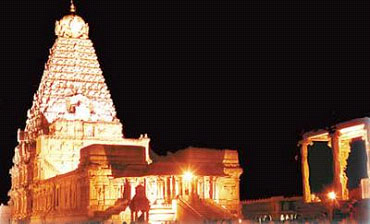
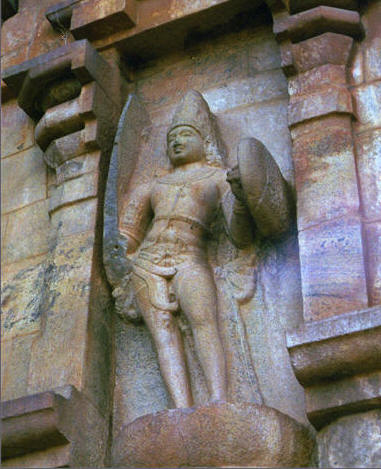
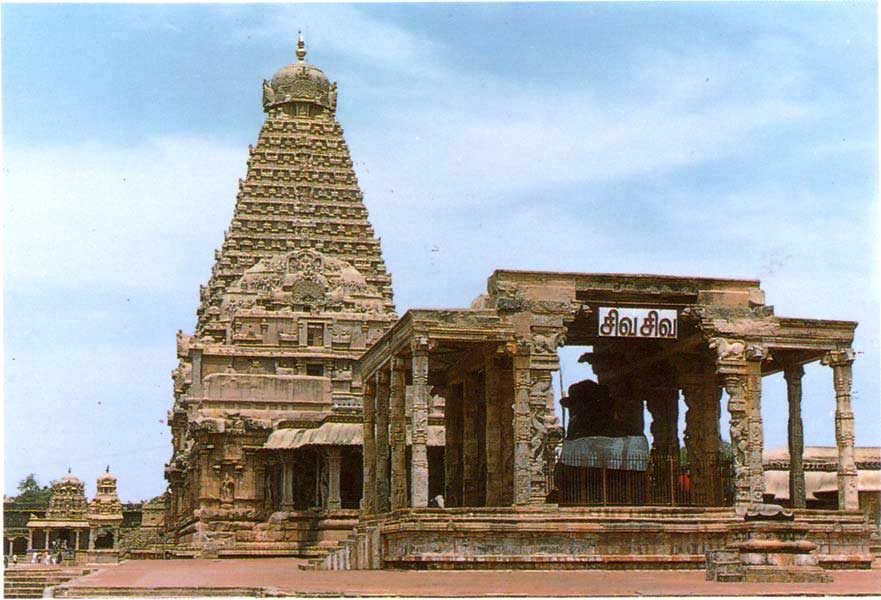
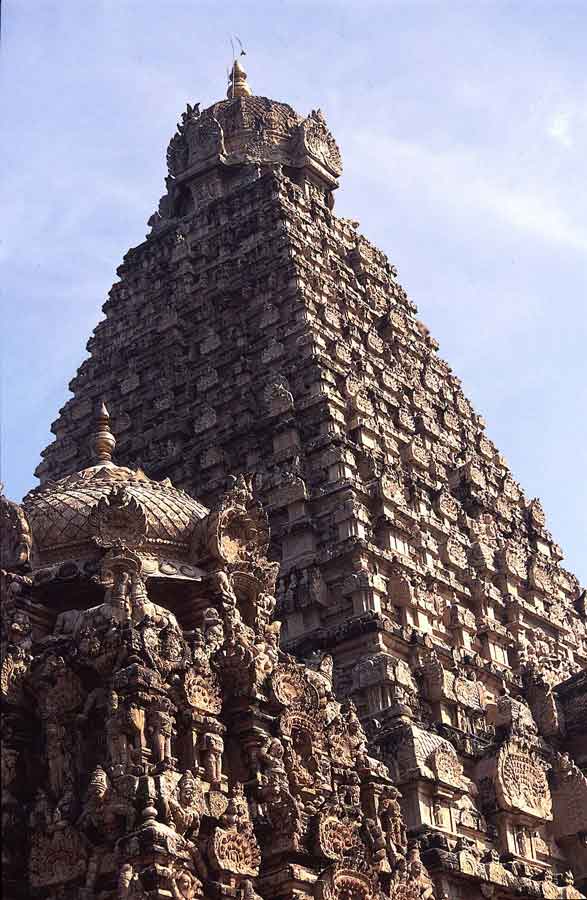
Capstone weighing 80 tons
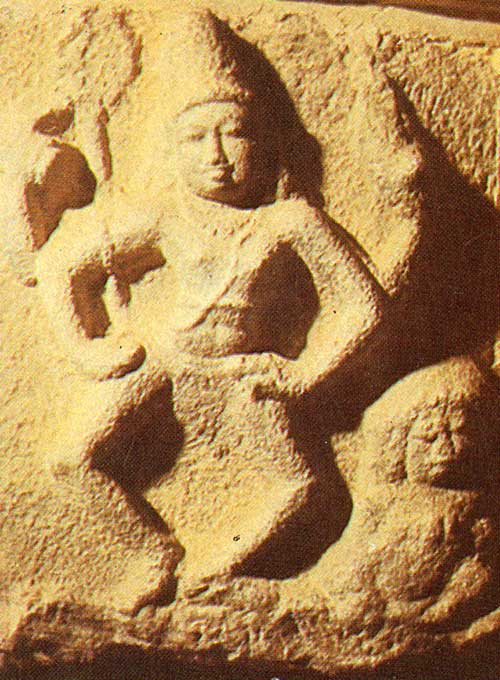
Dancer sitting in Aramandi